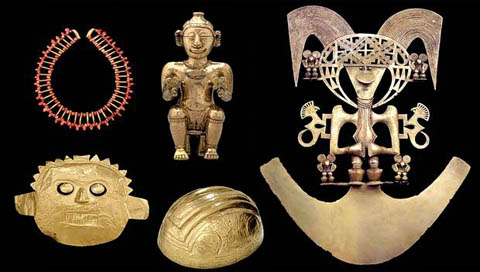-
Sylvhia.
User deleted
Lake Guatavita and the Myth of El Dorado

Lake Guatavita (a lake located near the town of Sesquilé, in the Cundinamarca department , about 60 kilometers from Bogota, capital of Colombia) is considered one of the sacred lakes of the pre-Columbian Muisca people. A ritual held right at this lake is widely acknowledged to be the basis of the famous legend of El Dorado, a legendary place where there would be immense quantity of gold and precious stones, as well as ancient esoteric knowledge. (Gonzalo Jiménez de Quesada)
(Gonzalo Jiménez de Quesada)
Legend says that, before the arrival of the conquistador Gonzalo Jimenez de Quesada, who discovered the site, the Muisca people practiced there religious rituals related to the worship of the sun.
In particular, the Guatavita Zipa applied resin and gold dust on his skin and forwarded to the center of the lake with a raft where he dived, performing ablutions taking off the gold dust off. Following the faithful cast into the lake other ritual offerings, such as pendants and precious jewelry.
Some objects made of gold and silver recovered in the bottom of the lake seem to confirm the veracity of this rite, although so far the research dives in the lake have found only a very small number of precious objects.
From this ceremony, of which the first Spaniard to be informed was Sebastian de Belalcazar, originated the myth of El Dorado that comes from the words in Spanish El Indio Dorado.During the centuries in many tried to recover the alleged treasures
In 1545 , the conquistadors Hernán Perez de Quesada (Gonzalo's brother) and Lázaro Fonte tried, unsuccessfully, to drain the lake with the simple technique of the human chain with containers, passed from hand to hand, removing small amount of water, constantly and for a long period of time. After 3 months the water level was lowered by 3 meters, but only small amounts of gold and precious stones were recovered, for a value of about 3000/4000 pesos.
In 1580 a more complex recovery operation was attempted, fielded by the of Bogota entrepreneur Antonio de Sepúlveda. A sort of deep channel about fifteen meters deep, to make the water flow out gradually was dug by hoes and picks on the lake border. After months of work, the final incision on the edge of the lakewe performed, a huge amounts of water spewed, but overwhelmed and killed some workers. The water level was reduced about 20 meters, before the walls of the channel, not sufficiently reinforced, collapsed, killing many native workers, buried by mud. This event brought an end to the work. One of the exhibits, including gold ornaments, emeralds and armor, was sent to King Philip II of Spain. The value of the finds of Sepúlveda is estimated at approximately 12,000 pesos. Nevertheless, the enterprise exhausted all his possessions and shortly afterwards he died in complete poverty. He was buried at the church of the village of Guatavita, where his remains still lie. (Philip II)
(Philip II)
1801 , Alexander von Humboldt paid a visit to Guatavita and, in his return to Paris, estimated that based on the findings of Sepúlveda the total value of the possible hidden treasures in the lake could amount to about three hundred million dollars. (Alexander von Humboldt)
(Alexander von Humboldt)
In 1898 , the company The Company for the Exploitation of the Lagoon of Guatavita that was taken over by the Contractors Ltd. of London was created . An underground tunnel was dug to create a hole in the center of the lake basin and drain. With this technique, the lake was drained successfully and almost completely, leaving a little over a meter of mud and sediment at bottom. But this made very difficult to identify artifacts in it, the more that, exposed to air, the mud solidified soon, creating compact clumps similar to concrete. The findings of precious not exceeded the value of about £ 500, then being auctioned at Sotheby's in London. The company eventually went bankrupt and ceased activities in 1929.
Currently the Lake Guatavita is a protected area by the Colombian government.
It is a mountain lake in the Andes, with the characteristics that are common to those of a meteor crater, although its origins have not yet been clarified. It has a diameter of about 1.5 km and a perimeter of about 5 km.
Located beside the lake there is the small town of Guatavita, tourism destination, albeit small in size.
In an area that overlooks the lake there are the remains of the native Muisca people. For questions related to the history of the site and to the sensitivity of the premises on the modalities of its conquest, this area is not accessible to visitors.*Attention please* - - "This translation (and / or content) is made by Sylvhia exclusively for "I Nove Mondi Forum". In case of partial or full release is mandatory to link to the original source and the required credits".
http://it.wikipedia.org/wiki/Laguna_di_Guatavita.
Lake Guatavita and the Myth of El Dorado |


